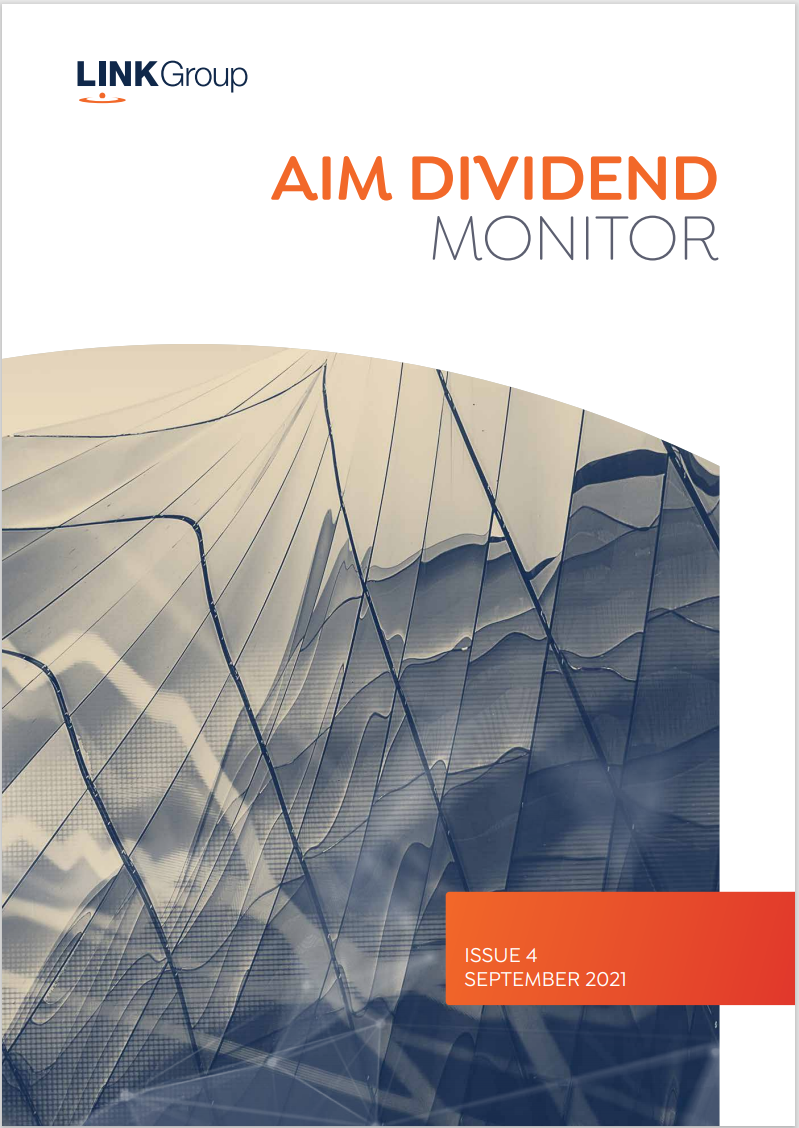AIM Dividend Monitor 2021
02 Sep 2021
AIM Dividend Monitor 2021
AIM dividends rebounding strongly after proving relatively resilient through the pandemic
- In the first year of the pandemic (April 2020 to March 2021) AIM dividends fell slightly less than the main market on an underlying basis; -40.4% v -41.6%
- AIM dividend payers were no more likely to cut payouts either, despite having less financial flexibility
- Q2 2021 saw the rebound begin – underlying dividends jumped 56.6%
- Every sector saw higher dividends in Q2, led by cyclicals
- For full year 2021, Link Group expects 32.2% growth on a headline basis to a total of £1,076m. The underlying increase is set to be 21.9%, significantly faster than the main market
- 2021 will see AIM’s payouts back to a level last reached in late 2018
Dividends from the junior AIM stock market showed remarkable resilience through the pandemic compared to the main market and are enjoying a strong rebound now, according to the latest annual AIM Dividend Monitor from Link Group.
AIM v Main Market
During 2020, underlying payouts fell to £753m, a 39.4% decline, towards the better end of Link Group’s expectations. The headline total (including special dividends) was £814m. Between April 2020 and March 2021 (the first four quarters of the pandemic) AIM payouts fell 40.4%, slightly better than the 41.6% decline on the main market. The favourable comparisons continue. AIM dividends fell back to a level last seen in 2016, but wider market payouts declined to 2011 levels. And two thirds of AIM companies that usually pay a dividend cut or cancelled their dividends. This too was no worse than the wider market.
Rebound
The recovery began in earnest in the second quarter of 2021. Underlying dividends (which exclude one-off special dividends) soared 56.6% to £265m. The headline Q2 figure was held back by lower one-off specials and rose 37%, following record special dividends in the first quarter. For the first half of 2021 overall, underlying dividends were seven percentage points better than Link Group’s best-case forecast made a year ago, before vaccine approvals were on the horizon. Headline growth for the first half was 40.7%. The rebound in underlying AIM dividends was also more than twice as strong as the main market in the first half.
Every sector saw higher dividends in Q2. Industrials, property, and building materials led the charge, all cyclically sensitive sectors enjoying a rebound, but IT companies also made a significant contribution to growth.
Outlook
The second half is likely to see a slower growth rate than in Q2. Link Group expects payouts to rise 24.2% on an underlying basis, slower than Q2 because a few companies delayed their payments in 2020 and these timetable effects are mostly going to unwind later this year. Dividend declines last year also became smaller with each passing quarter, so the comparisons become less favourable.
Link Group expects AIM dividends to rise 32.2% for the full year 2021 on a headline basis to a total of £1,076m. The underlying increase is set to be 21.9%, significantly faster than Link Group’s forecast for the wider market. The 2021 total would therefore restore AIM’s payouts back to a level last reached in late 2018.
Ian Stokes, Managing Director, Corporate Markets UK and Europe said:AIM companies are more vulnerable to economic disruption than their multi-national counterparts. They are less diversified and have more limited access to funding so they must move quickly to preserve cash to ensure they can ride out a brewing storm.
The pandemic has certainly been stormy, but despite the worst recession in two centuries, AIM companies have come through in good shape. They have been eager to restart dividends and the recovery has been blisteringly fast so far.
Even though relatively few AIM companies habitually pay dividends, those that do tend to grow them faster than the main market.
We are confident AIM’s dividends can regain their previous highs by some time in 2023, almost two years sooner than our expectation for the main market.
Detail on the 2020 cuts
The diverse industrials sector is the largest on AIM and also usually contributes most to the junior market’s dividends. Cuts here made the biggest impact. In common with the main market, retail, travel and leisure saw the biggest declines in percentage terms, along with other consumer discretionary sectors. The only sector to see an increase in the worst period was the defensive basic consumer goods group. Over the first four quarters of the pandemic, just one AIM company in five paid a dividend, much less than the typical one in three.
The five largest dividend payers on the main market have typically contributed 35% of the total paid, but on AIM the top five are only responsible for 17%. This main-market concentration proved costly when four of 2019’s top payers[1] cut or cancelled dividends. Between them these four alone accounted for more than two fifths (43%) of the fall in UK plc payouts between April 2020 and March 2021. On AIM, by contrast, the top five contributed less than one fifth of the fall (18.7%), roughly in line with their overall share total AIM dividends. Moreover, banks were barred by the PRA from dividend paying full stop – they normally make up £1 in every £7 of UK plc payouts on the main market, but there are almost no AIM banks.[2] This all helps explain why the dividend decline on the junior market was no worse than on the main market.
[1] Shell, HSBC, BP, Rio Tinto
[2] There is lots more detail on all of this in issues 45 and 46 of the UK Dividend Monitor available on the Link Group website.





